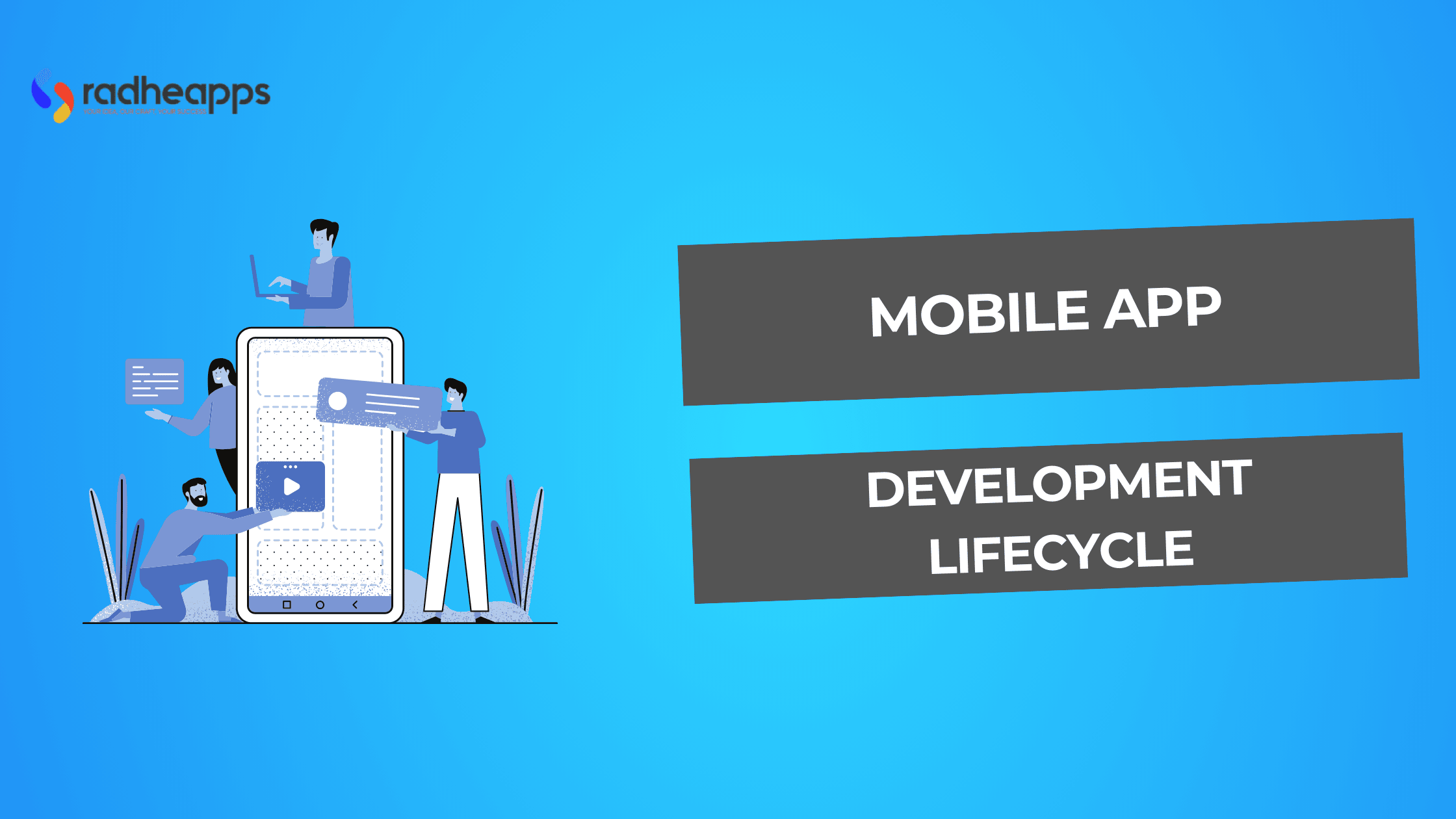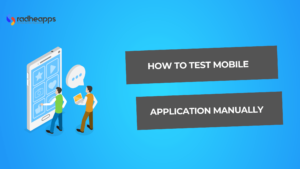A mobile application is more than just an option; it is a part of life to fulfill daily requirements. Whether you are an early-stage startup planning to launch an innovative product or an existing business looking to improve customer engagement. Following a proper structure of the mobile app development lifecycle is crucial.
Development of a high-value mobile app is much more than writing code to provide features and value to users. A high-quality app begins with a well-defined strategy and structured plan to provide the right features and functionalities during development.
All strategies, plans, and processes should be aligned with the development process’s lifecycle. Understanding the app’s target audience is vital for app performance and scalability.
But without the right expertise, your app can quickly become a failure, infected with bugs, poor usability, and low retention rates. This is where we, Radheapps, focused.
As a leading mobile app development partner, we collaborate with businesses to build functional mobile applications. We plan, design, and develop their ideas into fully functional applications ready to take over the market.
Whether you want a fully customized app development plan, add AI to personalize the user experience, or just build a cost-effective, high-performance mobile app to support new 5G capabilities, our team provides a seamless process to get one.
Contact Radheapps today, and let’s create an app that drives growth, engagement, and lasting success.
OR
Consult your vision with us and let’s make something remarkable!
What is Mobile App Development Lifecycle?
The Mobile App Development Lifecycle (MADL) is a process for developing a mobile application from scratch to deployment and maintenance. It includes structured key stages to maximize efficiency. The MADL process allows developers to plan, design, and effectively develop an app.
A process that has a well-structured app development lifecycle has many benefits. This process outlines a defined path that reduces the chances of complications during development. Following guidelines, development teams can manage resources effectively, streamline workflows, and minimize development costs.
A structured mobile app can quickly scale with multiple features without interrupting core functionality. Implement high-end security with best practices for storing data securely and coding standards. The MADL can help address proposed improvements, especially in the ever-evolving digital landscape.
Why Does Understanding the Mobile App Development Lifecycle Matter?
The mobile app development lifecycle is crucial for creating successful applications. A well-structured, developed app meets user expectations, is up to industry standards, and is scalable for future growth. However, app development can become inefficient if proper guidelines are not followed.
The Impact of a Structured Approach on Success
A structured approach to developing a mobile app increases efficiency, reduces risks, and guarantees a higher-quality deployment. Developers who follow a well-structured process can use resources more efficiently, prevent redundant coding, and proactively manage the development process.
Moreover, by following a systematic approach, teams can efficiently collaborate to support the designers, developers, and marketers. This collaboration can deliver a product that meets business goals and user needs.
Common Pitfalls of Skipping Key Development Phases
If you skip these key development phases, you can face functionality issues, performance issues, and even security exposures. For example, skipping the research and planning phases can result in an app that lacks market demand or fails to address user pain points.
Additionally, not testing an app properly can lead to performance issues, app crashes, or security flaws. These mistakes impact a negative user experience and increase the company’s cost for fixing errors that can be avoided.
How Businesses Can Optimize Their App Lifecycle
Businesses can optimize their app lifecycle by focusing on user feedback and strategic updates with these proven strategies. Investing in thorough market research helps fulfil user needs, which ensures the app is built with a clear purpose. Agile methodologies can be helpful in making an app flexible and making quick adjustments.
App testing, deployment, and analytics automation tools can enhance efficiency and accuracy. Additionally, long-term maintenance and updates should be planned to keep the app relevant and secure.
By proactively managing the app lifecycle, businesses can maximize user engagement, improve retention rates, and achieve long-term success.
How to Define the Scope and Vision of Your App
A well-defined scope and vision for your mobile app are the foundation for a successful development process. Defining the app’s purpose, target audience, and market potential is key.
Identify the Problem Your App Solves
All successful apps exist to solve a problem or fulfill a specific need. Businesses need to do the research, examine competitors, and listen to users’ problems or needs. Companies can develop a compelling and enduring solution if they understand the pain point. An app can solve their problem by improving communication.
Clarity on the problem will also provide direction for focusing on features and potential functions. Consequently, user-centric features and functions reduce challenges and maximize success rates.
Set Clear Objectives and Success Metrics
After identifying a problem, set clear objectives and success metrics for the app. Objectives should be aligned with business objectives. Establishing these criteria initially allows businesses to track progress, make data-driven decisions, and refine strategies based on user behavior.
Create a Roadmap for Development
A well-structured roadmap provides a timeline and framework for development. It offers key milestones to support teams in staying organized and efficient. A structured roadmap includes wireframing, UX design, backend development, testing phases, and launch guides.
Key Phases in Mobile App Development
A well-structured process must be followed to develop a mobile application efficiently. Let’s learn about mobile app development lifecycle steps:
Research and Planning
- Market Research and User Analysis: Understand your audience’s needs, behaviors, and pain points when designing for them. This will assist in the development of a solution-focused application.
- Competitive Analysis: Benchmark competitors’ strengths and weaknesses to identify and fill the gaps for your business.
- Establish Key Features: Include must-have features and your unique value proposition to ensure the application is well-optimized.
UI/UX Design and Prototype
- Sketch Wireframes and User Flows: Wireframes help imagine the structure and flow of the application.
- Picking a Design for Consistency: A design system is vital to ensure optimization across screen sizes and devices. Follow the best UI/UX design and development practices to deliver the best results.
- Testing with Potential Users: Feedback from real users refines the design. Test UI/UX with the tool Figma to ensure the best outcomes.
Development and Architecture
- Select the Right Tech Stacks: The appropriate framework and programming language provide the application with optimum performance and scalability. You can choose the AppGyver tool for no-code app development.
- Frontend vs. Backend Consideration: The balance of the frontend design and the backend ensures the application will perform efficiently.
- Database Management and API Integration: Efficient data management and seamless integration of third-party APIs improve the application’s usability. Use Google’s Firebase to manage the database and the Postman tool for API integration.
Test for Performance and Security
- Unit Testing, Integration Testing, and Usability Testing: Fix bugs at different levels to prevent significant issues post-deployment. Click here for a step-by-step guide to the mobile testing phases.
- Ensuring App Security and Data Protection: Implement encryption, authentication protocols, and security best practices.
- Beta Testing and Gathering User Feedback: Beta testing with real users before the official launch to make potential improvements. To test an Apple application, use TestFlight – Apple Developer for better outcomes.
Deployment and Launch Strategy
- Prepare for App Store and Google Play Submission: Stick to platform-specific guidelines to prevent rejection.
- Compliance with Platform Guidelines: Align the app policies with Google Play and App Store regulations to avoid delays.
- Market and User Acquisition Plans: Effective marketing and user engagement strategies on app stores boost downloads.
Post-launch Growth and Optimization
- Examine User Engagement and App Functionality: Use analytics software to track user engagement, retention, and areas for improvement.
- Introduce Updates and New Features: Frequent updates provide your app with improved functionality and bug fixes. Integrate the app with better features to offer better user engagement.
- Retention Strategies to Keep Users Engaged: Push notifications, personalized features, and loyalty programs to maintain interest.
Emerging Trends in Mobile App Development
Technology is transforming mobile app development by emerging trends that can improve user experience, security, and performance. New trends, such as AI-driven personalized experiences, 5G technology, and blockchain technology, are redefining app functionality to become highly secure and intuitive.
AI-Driven Personalization
AI changes mobile apps’ functionality by analyzing user behavior, preferences and users’ interactions to provide individualized content, product recommendations, and features.
- Improved User Engagement: Apps can help improve user experience and retention rates by providing personalized content, product recommendations, and curated news feeds.
- AI Chatbots and Assistants: AI-powered chatbots offer enhanced customer service through instant replies and support.
- Predictive Analytics: Predictive analysis powered by AI can analyze users’ historical data related to your app and improve functionality and marketing strategies.
5g and Its Impact on App Performance
Mobile applications are experiencing faster speeds, lower latency, and improved overall performance after the 5G launch.
- Lightning-Fast Connectivity: 5G enables real-time data transfer and reduces lag in cloud-based applications.
- Improved AR/VR Experiences: Augmented and virtual reality applications can operate seamlessly and provide immersive experiences.
- Better IoT Integration: 5G facilitates improved communication between connected devices and IoT-based applications more efficiently.
Blockchain for Enhanced Security
Blockchain technology has enhanced security for mobile applications by providing decentralized solutions.
- Data Integrity and Security: Blockchain protects sensitive data from unauthorized access.
- Secure Payments and Transactions: Cryptocurrency and blockchain-based payment systems allow you to transact safely.
- Decentralized Applications (DApps): Blockchain networks enhance security without needing centralized control.
Conclusion
A successful mobile app is developed when it goes through a comprehensive development process, a robust technology framework, and quick development to fulfill user needs.
Every stage of the development process is vital for the app’s success. This includes R&D, UI/UX designs, testing, and post-launch strategies. Keep up with the emerging trends like AI, faster 5G, and blockchain, in mobile app development to provide seamless and enhanced performance.
This also allows you to integrate with enhanced security to provide an engaging user experience. The complexities of navigation mobile app development can be stressful without expert guidance. This is where Radheapps comes in.
Our experienced developers, designers, and strategists collaborate with you to create a scalable and user-friendly mobile application. Whether you are planning a new mobile app or developing an existing application, we promise a smooth and easy mobile app development roadmap.
Get your idea on our table to make it a reality and launch your innovative future mobile app today.
Contact us today to begin developing your new, creative, and cutting-edge mobile experience!
Frequently Asked Questions (FAQs)
How can I Ensure my App is Scalable from the Start?
To ensure your app is scalable from the start, focus on a modular architecture, efficient code, cloud-based infrastructure, and robust testing. Consider caching, load balancing, and asynchronous processing.
What are the Best Testing Practices for Mobile Apps?
To ensure a high-quality mobile app, the best testing practices include testing early and frequently, using real devices in diverse environments, focusing on usability, and incorporating various types of testing.
How often should I Update my App after Launch?
Reputable companies release minor application updates once every 20-40 days.
What Factors Influence Mobile App Development Costs?
The cost of mobile app development is determined by several factors, such as app complexity, the number of features, platform choice (iOS, Android, or both), design requirements, development time, and the expertise.




